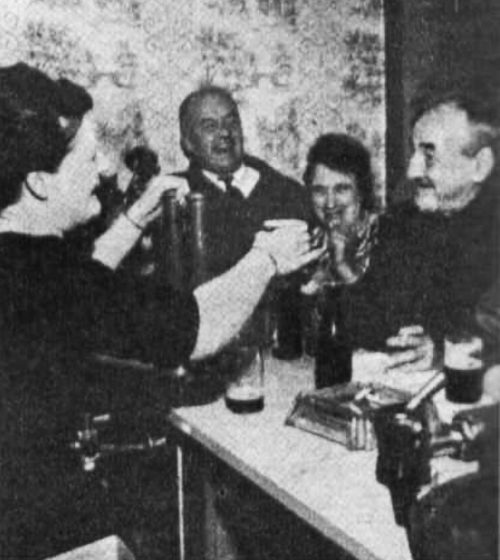The end of a street
A Granada documentary looks at ‘slum clearance’ in Oldham


A GIANT yellow bulldozer squeals and rumbles its way along a slum street. It snatches at a steel cable girdling a derelict house.
The crumbling roof sags, rotten walls totter and the eyeless sockets of windows are swallowed up in a cloud of brick and plaster dust.
It’s the end of a street. The end of a lifetime. The houses were bad. So was the past.
For nine weeks these yellow giants fascinated director-producer Norman Swallow as he headed a team of 26 technicians following in their destructive wake.
He watched the heart being torn out of the slums at Oldham, Lancs, where 1,000 houses are due for demolition.
His recordings and impressions will be screened as The End of a Street on Wednesday.

The project started on June 1. Swallow went out into the slum streets and picked his “cast” from the people he met. And he talked to hundreds of people in St. Mary’s ward of the town.
You will meet people like Mrs. Ellen Cartwright — Nellie the waitress as they knew her — at the Canteen Inn which will shortly be bulldozed into a heap of rubble and memories.
Nellie wept when the bulldozer tore into her two-up-two-down at No. 27 William Street.
“I saw it go brick by brick … and I cried. All my children were born there,” she said. She vows she’ll return to St. Mary’s ward as soon as the new flats start going up.
The End of a Street is a kaleidoscope of fears and hopes, of crumbled wood and stifled sobs.
Like the man who tells: “I was married there. My father lived there, my mother. My children were born there. It’s like someone you love being hurt.”


A community spirit existed there that can’t be traced on the new estates. There was Alice Buckley. Plump, jolly and homely.
When a pensioner was made homeless across the street, she took him in. “Like a stray dog,” she joked. “And he’ll come with me and my husband whenever we move.”
The lodger is 72-year-old Billy Travis, a bright-eyed little man in muffler and cloth cap, who was known throughout the district as Billy Borndrunk.
“Beer? I thrive on it,” he roared. “And I take my nickname in good part. I’ve had some good friends in these parts.
“But I’ll survive. As long as there’s a pub, a dart-board and a box of dominoes.”
Norman Swallow said: “We found lots of old people who did not want to go but after they had got a new council house they agreed it was like being on holiday for always.”
The End of a Street shows how much the problem is one of age. In a forum of five teenagers, college girl Anne Greaves pointed out: “Some old people are snobbish. And I can understand their point of view when they have no roots in their new surroundings.”
Schoolgirl Christine Cottrill detests her home town: “I don’t want to stay and live in it. It’s a dirty grimy hole. There are too many mill chimneys.”
The youngsters long for coffee bars, dance halls and amusements that cannot be found on new estates. But they are 4-1 in favour of staying in Oldham.
You will also see the “planners” — the men at the town hall who govern the people’s fate.
Of his title, Norman Swallow said: “The word ‘end’ means not only the physical destruction of the houses but the deeper destruction of the society they represent. Friendships are smashed as well as buildings. It is a dramatic moment in their lives.”
The programme, which has taken six months to produce from the original idea to the final editing, considers the wholesale destruction of 1,000 homes and its effect on 4,000 people. Swallow calls it, arguably, the town’s second Revolution.



